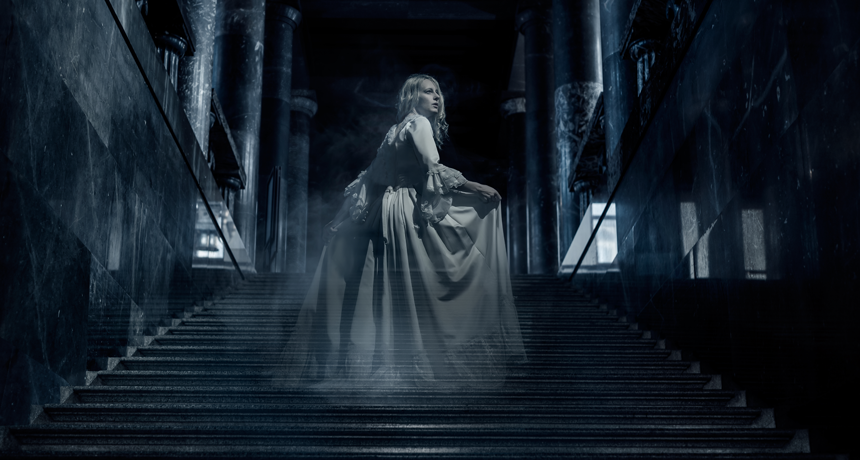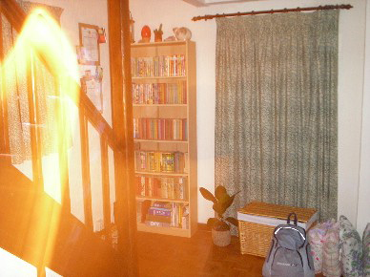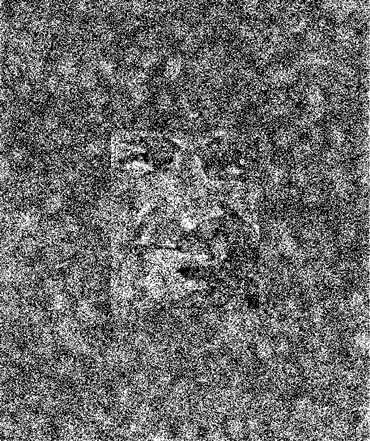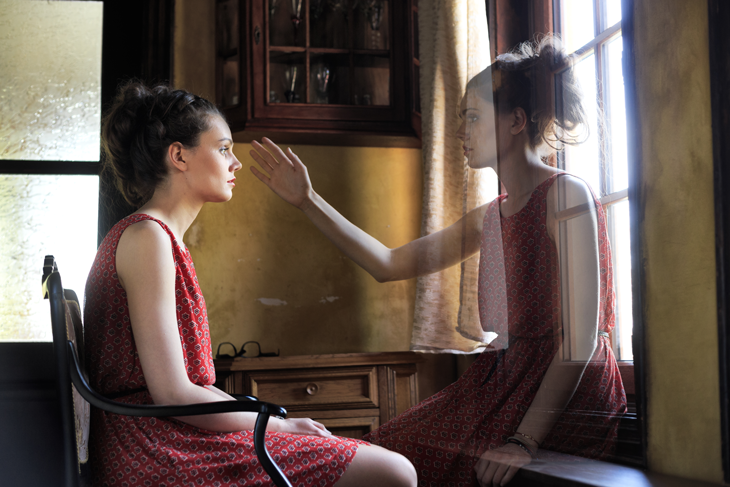The science of ghosts
Here’s what may explain why some people see, hear or feel a spooky presence

People love scary, spooky stories of spectral phantoms. While there’s no science to support the existence of ghosts, research does provide plenty of explanations for why we might genuinely sense a supernatural presence.
D-Keine/E+/Getty Images
A shadowy figure rushed through the door. “It had a skeletal body, surrounded by a white, blurry aura,” recalls Dom. The figure hovered and didn’t seem to have a face. Dom, who prefers to use only his first name, had been fast asleep. Just 15 at the time, he panicked and closed his eyes. “I only saw it for a second,” he recalls. Now, he’s a young adult who lives in the United Kingdom. But he still remembers the experience vividly.
Was the figure a ghost? In the mythology of the United States and many other Western cultures, a ghost or spirit is a dead person who interacts with the living world. In stories, a ghost may whisper or groan, cause things to move or fall, mess with electronics — even appear as a shadowy, blurry or see-through figure.

Ghost stories are lots of fun, especially on Halloween. But some people believe that ghosts are real. Chapman University in Orange, Calif., runs a yearly survey that asks people in the United States about their beliefs in the paranormal. In 2018, 58 percent of those polled agreed with the statement, “Places can be haunted by spirits.” And almost one in five people from the United States said in another survey, conducted by the Pew Research Center in Washington, D.C., that they’ve seen or been in the presence of a ghost.
On ghost-hunting TV shows, people use scientific equipment to attempt to record or measure spirit activity. And numerous creepy photos and videos make it seem like ghosts exist. However, none of these offer good evidence of ghosts. Some are hoaxes, created to fool people. The rest only prove that equipment sometimes can capture noise, images or other signals that people don’t expect. Ghosts are the least likely of many possible explanations.
Not only are ghosts supposed to be able to do things that science says are impossible, such as turn invisible or pass through walls, but also scientists using reliable research methods have found zero evidence that ghosts exist. What scientists have discovered, though, are lots of reasons why people might feel they have had ghostly encounters.
What their data show is that you can’t always trust your eyes, ears or brain.
‘Dreaming with your eyes open’
Dom began having unusual experiences when he was eight or nine. He would wake up unable to move. He researched what was happening to him. And he learned that science had a name for it: sleep paralysis. This condition leaves someone feeling awake but paralyzed, or frozen in place. He can’t move or speak or breathe deeply. He may also see, hear or feel figures or creatures that aren’t really there. This is called a hallucination (Huh-LU-sih-NA-shun).
Sometimes, Dom hallucinated that creatures were walking or sitting on him. Other times, he heard screaming. He only saw something that one time, as a teenager.
Sleep paralysis happens when the brain messes up the process of falling asleep or waking. Usually, you only start dreaming after you’re fully asleep. And you stop dreaming before you waken.

Sleep paralysis “is like dreaming with your eyes open,” explains Baland Jalal. A neuroscientist, he studies sleep paralysis at the University of Cambridge in England. He says this is why it happens: Our most vivid, lifelike dreams happen during a certain stage of sleep. It’s called rapid eye movement, or REM, sleep. In this stage, your eyes dart around under their closed lids. Though your eyes move, the rest of your body can’t. It’s paralyzed. Most likely, that’s to prevent people from acting out their dreams. (That could get dangerous! Imagine flailing your arms and legs as you play dream basketball, only to whack your knuckles on the wall and tumble to the floor.)
Your brain usually turns this paralysis off before you wake up. But in sleep paralysis, you wake up while it’s still happening.
Faces in the clouds
You don’t have to experience sleep paralysis to sense things that aren’t there. Have you ever felt your phone buzz, then checked to find there was no message? Have you heard someone calling your name when no one was there? Have you ever seen a face or figure in a dark shadow?
These misperceptions also count as hallucinations, says David Smailes. He’s a psychologist in England at Northumbria University in Newcastle-upon-Tyne. He thinks that just about everyone has such experiences. Most of us just ignore them. But some may turn to ghosts as the explanation.
We’re used to our senses giving us accurate information about the world. So when experiencing a hallucination, our first instinct is usually to believe it. If you see or feel the presence of a loved one who died — and trust your perceptions — then “it has to be a ghost,” says Smailes. That’s easier to believe than the idea that your brain is lying to you.
The brain has a tough job. Information from the world bombards you as a mixed-up jumble of signals. The eyes take in color. The ears take in sounds. The skin senses pressure. The brain works to make sense of this mess. This is called bottom-up processing. And the brain is very good at it. It’s so good that it sometimes finds meaning in meaningless things. This is known as pareidolia (Pear-eye-DOH-lee-ah). You experience it whenever you stare at clouds and see rabbits, ships or faces. Or gaze at the moon and see a face.

The brain also does top-down processing. It adds information to your perception of the world. Most of the time, there is way too much stuff coming in through the senses. Paying attention to all of it would overwhelm you. So your brain picks out the most important parts. And then it fills in the rest. “The vast majority of perception is the brain filling in the gaps,” explains Smailes.
What you see right now isn’t what’s actually out there in the world. It’s a picture your brain painted for you based on signals captured by your eyes. The same goes for your other senses. Most of the time, this picture is accurate. But sometimes, the brain adds things that aren’t there.
For example, when you mishear the lyrics in a song, your brain filled in a meaning that wasn’t there. (And it will most likely continue to mishear those words even after you learn the right ones.)
This is very similar to what happens when so-called ghost hunters capture sounds that they say are ghosts speaking. (They call this electronic voice phenomenon, or EVP.) The recording is probably just random noise. If you listen to it without knowing what was supposedly said, you probably won’t hear words. But when you know what the words are supposed to be, you might now find that you can discern them easily.
Your brain may also add faces to images of random noise. Research has shown that patients who experience visual hallucinations are more likely than normal to experience pareidolia — see faces in random shapes, for instance.
In one 2018 study, Smailes’ team tested whether this might also be true for healthy people. They recruited 82 volunteers. First, the researchers asked a series of questions about how often these volunteers had hallucination-like experiences. For example, “Do you ever see things other people cannot?” and “Do you ever think that everyday things look abnormal to you?”

Next, the participants looked at 60 images of black and white noise. For a very brief moment, another image would flash in the center of the noise. Twelve of these images were faces that were easy to see. Another 24 were hard-to-see faces. And 24 more images showed no faces at all — just more noise. The volunteers had to report whether a face was present or absent in each flash. In a separate test, the researchers showed the same volunteers a series of 36 images. Two-thirds of them contained a face pareidolia. The remaining 12 did not.
Participants who had initially reported more hallucination-like experiences were also more likely to report faces in the flashes of random noise. They were also better at identifying those images that contained face pareidolia.
In the next few years, Smailes plans to study situations in which people might be more likely to see faces in randomness.
When people sense ghosts, he points out, “They’re often alone, in the dark and scared.” If it’s dark, your brain can’t get much visual information from the world. It has to create more of your reality for you. In this type of situation, Smailes says, the brain may be more likely to impose its own creations onto reality.
Did you see the gorilla?
The brain’s picture of reality sometimes includes things that aren’t there. But it can also completely miss things that are there. This is called inattentional blindness. Want to know how it works? Watch the video before you keep reading.
The video shows people in white and black shirts passing a basketball. Count how many times the people in white shirts pass the ball. How many did you see?
Partway through the video, a person in a gorilla suit walks through the players. Did you see it? About half of all viewers who count passes while watching the video miss the gorilla completely.
If you too missed the gorilla, you experienced inattentional blindness. You were likely in a state called absorption. That’s when you are so focused on a task that you tune out everything else.
“Memory does not work like a video camera,” says Christopher French. He is a psychologist in England at Goldsmiths University of London. You only remember things you’re paying attention to. Some people are more likely to become absorbed than others. And these people also report higher levels of paranormal beliefs, he says, including beliefs in ghosts.
How could these things be related? Some strange experiences that people blame on ghosts involve unexplained sounds or movements. A window may seem to open all by itself. But what if someone opened it and you just didn’t notice because you were so absorbed in something else? That’s a lot more likely than a ghost, French says.
In one 2014 study, French and his colleagues found that people with higher levels of paranormal beliefs and higher tendencies to get absorbed are also more likely to experience inattentional blindness. They also tend to have a more limited working memory. That’s how much information you can hold in your memory at once.
If you have trouble keeping lots of information in your memory or paying attention to more than one thing at once, then you risk missing sensory cues from the environment around you. And you might blame any misperceptions that result on a ghost.
The power of critical thinking
Anyone may experience sleep paralysis, hallucinations, pareidolia or inattentional blindness. But not everyone turns to ghosts or other supernatural beings as a way to explain these experiences. Even as a child, Dom never thought he had come face to face with a real ghost. He went online and asked questions about what might have happened. He used critical thinking. And he got the answers he needed. When an episode happens now, he uses a technique that Jalal developed. Dom doesn’t try to stop the episode. He just focuses on his breathing, tries to relax as much as possible and waits for it to pass. He says, “I deal with it far better. I just sleep and enjoy sleeping.”
Robyn Andrews is a psychology student at the University of South Wales in Treforest. She wondered if people with stronger critical-thinking skills might be less likely to believe in the paranormal. So she and her mentor, psychologist Philip Tyson, recruited 687 students for a study about their paranormal beliefs. The students majored in a wide range of different fields. Each was asked how strongly he or she agreed with statements such as, “It is possible to communicate with the dead.” Or “Your mind or soul can leave your body and travel.” The research team also looked at the students’ grades on a recent assignment.

Students with higher grades tended to have lower levels of paranormal beliefs, this study found. And students in the physical sciences, engineering or math tended not to believe as strongly as those studying the arts. This trend also has been seen in research by others.
This study did not actually assess the students’ ability to think critically. “That’s something we would look into as a future study,” says Andrews. However, previous research has shown that science students tend to have stronger critical-thinking skills than art students. That’s probably because you need to think critically in order to conduct scientific experiments. And thinking critically can help you scout out likely causes for an unusual experience without involving ghosts (or aliens, or Bigfoot).
Even among science students and working scientists, though, paranormal beliefs persist. Andrews and Tyson think that’s a problem. If you can’t judge whether a ghost story or spooky experience is real or not, you may also get fooled by advertisements, bogus medical cures or fake news, says Tyson. It’s important for everyone to learn how to question information and seek reasonable, realistic explanations.
So if someone tells you a ghost story this Halloween, enjoy it. But remain skeptical. Think about other possible explanations for what was described. Remember that your mind may fool you into experiencing spooky things.
Wait, what’s that behind you? (Boo!)
Kathryn Hulick has been a regular contributor to Science News for Students since 2013. She’s covered everything from laser “photography” and acne to video games, robotics and forensics. This piece — her 43rd story for us — was inspired by her book: Strange But True: 10 of the world’s greatest mysteries explained. (Quarto, October 1, 2019, 128 pages).







